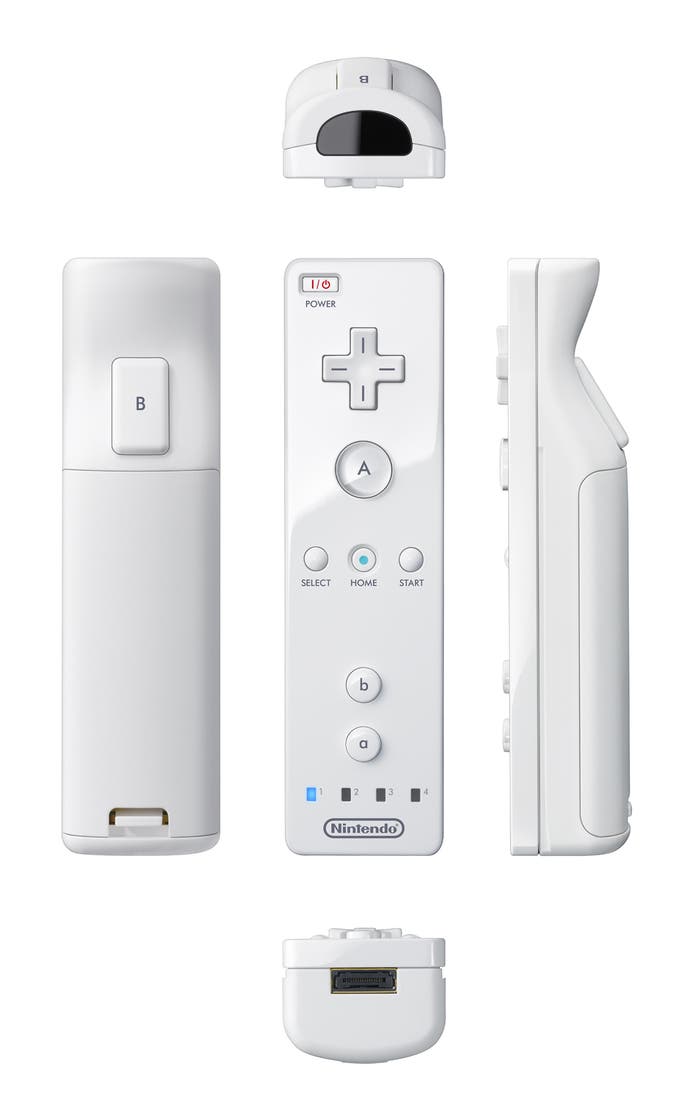Revolution controller - not remotely what we expected
Just clicks.
The Revolution will not be televised, but it will owe thanks to the ubiquity of television remote controls, it emerged today, as Satoru Iwata revealed that Nintendo's next-generation game controller is a one-handed, movement-sensitive, TV-remote-control-shaped wireless device that allows players to direct actions through gestures as well as button presses.
The practical applications of the controller could be fascinating. Iwata presented a concept video showing how this might work, as gamers of various ages swung the controller like a baseball bat, fired it like a pistol, whipped it like a lasso, gestured with it like a conductor, and even flipped the tip up and down to the familiar sound of the Mario Bros. jumping effect.
Players will also be able to plug in various expansion controllers through a port on the bottom of the unit, including a classic expansion to allow traditional control of the Revolution's back-catalogue titles, and an analogue stick device with Z1 and Z2 triggers for what Iwata jokingly referred to as a "nunchuck-style expansion" - presumably more in terms of looks than action. It will also be possible for gamers to use two controllers at once.
A sensor embedded in the top of the controller, called the Direct Pointing Device, will allow Revolution to sense the distance between the controller and the screen, where it's pointing, and the angle it's being held at. A D-pad rests in comfortable reach of the player's thumb on the face of the controller, with an A button directly beneath it, and a trigger B button on the reverse. Players will be able to hold the controller in various ways - and Iwata said the company was "eager to establish a new standard of play for first-person shooter games," for example.

The controller also features a trio of buttons in the centre - Select, Home, and Start - with lowercase "b" and "a" function buttons positioned one above the other toward the bottom. Some prototypes have X and Y instead, but these lowercase a/b buttons appear sideways to indicate that the controller can also be held sideways and used much like a NES control pad. There's also an On/Off switch for the console in the top-left corner - just as though it were a TV remote control - and four icons along the bottom of the controller to indicate the player number. Finally, Nintendo says it will feature built-in rumble functionality and room for batteries ala the GameCube WaveBird wireless pad.
Iwata did not present any Revolution games during his keynote address - and yes, that means Mario 128 was absent from the event, despite the presence of designer Shigeru Miyamoto in the audience - preferring instead to concentrate on the controller design itself, arguing that it was necessary to design a device that both gamers and non-gamers would find acceptable. "We face the reality that within one family there are people willing to pick up a game controller, and those who would never touch one. Anyone will pick a TV remote control, but not necessarily a game controller. Why is this? We thought it was the requirement of moving right and left fingers separately and nimbly that was creating a psychological barrier. To expand the gaming population, it was needed for us to design a pad so that any family member would see it on the living room table, think that this was something relevant to them and pick it up."
Key developers appeared on the video screen to comment. All reflected on the boldness of the move. Perhaps the most prominent for Western audiences, Konami's Hideo Kojima, said he was "pleasantly surprised". "Even though it was a surprise to me at first, I quickly understood how it should be used."
As well as lowering the hurdle for new and returning gamers, Iwata also said that he felt the controller would allow developers intimidated by the demands of PlayStation 3 and Xbox 360 to find a new home for their work. "It can be a benefit to gamers and the industry," he said. "Nintendo wants to provide a stage on which to showcase your ideas. Nintendo is willing to help bring these ideas to life. If seeing the controller today sparks great ideas, Nintendo is waiting for your proposals."
But he was quick to add that he still expected Revolution to play host to games of more traditional size and depth. "We are not only going to offer small and simple games. Rather, with this controller, we are going to establish a brand new standard for game control," he said. "We needed to satisfy both the novice gamers, and veteran gamers who want big, deep, highly complex new games."
"I believe that it is the job of all of us who are creators of great entertainment to continue to surprise people, and constant innovation is the key," he concluded.
The controller understandably drew gasps from the crowd huddled inside the rather small International Conference Hall at the Makuhari Messe Convention Center outside Tokyo - and is likely to be a significant talking point in the weeks to come. Several big questions already present themselves, including the question of how Nintendo will overcome the various technical issues that could derail its efforts - including compatibility with varying television standards. We hope to have answers to these within the next few hours as we continue our coverage of the Tokyo Game Show.

